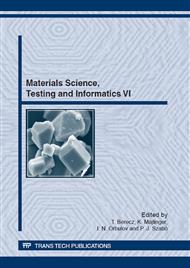[1]
O. V. Mishin, V. Y. Gertsman, G. Gottstein, Distributions of orientations and misorientations in hot-rolled copper, Materials Characterization 38 (1997) 39-48.
DOI: 10.1016/s1044-5803(96)00130-1
Google Scholar
[2]
S. Y. Lee, Y. B. Chun, J. W. Han, S. K. Hwang, Effect of thermomechanical processing on grain boundary characteristics in two-phase brass, Materials Science and Engineering A 363 (2003) 307-315.
DOI: 10.1016/s0921-5093(03)00668-3
Google Scholar
[3]
V. Randle, G. S. Rohrer, H. M. Miller, M. Coleman, G. T. Owen, Five-parameter grain boundary distribution of commercially grain boundary engineered nickel and copper, Acta Materialia 56 (2008) 2363-2373.
DOI: 10.1016/j.actamat.2008.01.039
Google Scholar
[4]
V. Randle, Y. Hu, M. Coleman, Grain boundary reorientation in copper, J Mater Sci 43 (2008) 3782-3791.
DOI: 10.1007/s10853-007-2128-2
Google Scholar
[5]
W. E. King, A. J. Schwartz, Toward optimization of the grain boundary character distribution in OFE copper, Scripta Materialia Vol. 38 No 3 (1998) 449-455.
DOI: 10.1016/s1359-6462(97)00486-7
Google Scholar
[6]
V. Randle, M. Coleman, A study of low-strain and medium-strain grain boundary engineering, Acta Materialia 57 (2009) 3410-3421.
DOI: 10.1016/j.actamat.2009.04.002
Google Scholar
[7]
C. A. Schuh, M. Kumar, W. E. King, Analysis of grain boundary networks and their evolution during grain boundary engineering, Acta Materialia 51 (2003) 687-700.
DOI: 10.1016/s1359-6454(02)00447-0
Google Scholar
[8]
S. Xia, B. Zhou, W. Chen, Effect of single-step strain and annealing on grain boundary character distribution and intergranular corrosion in Alloy 690, J Mater Sci 43 (2008) 2990-3000.
DOI: 10.1007/s10853-007-2164-y
Google Scholar
[9]
C: B: Thomson, V. Randle, Fine tuning, at Σ3n boundaries in nickel, Acta Mater. Vol. 45 No 12 (1997) 4909-4916.
DOI: 10.1016/s1359-6454(97)00192-4
Google Scholar
[10]
V. Randle, R. Jones, Grain boundary plane distributions and single-step versus multiple-step grain boundary engineering, Materials Science and Engineering A 524 (2009) 134-142.
DOI: 10.1016/j.msea.2009.06.018
Google Scholar


